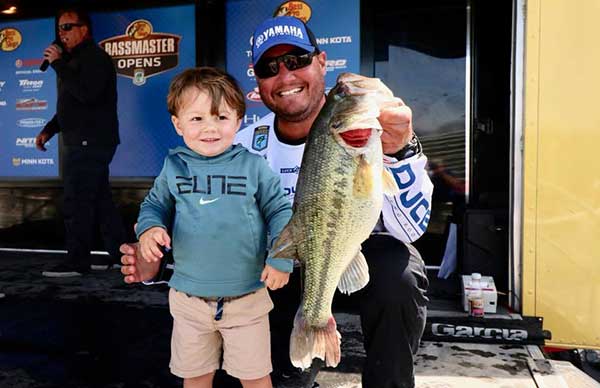By David A. Rose
 Missing Strikes When Fishing Topwater Baits? It Might be Your Line Choice
Missing Strikes When Fishing Topwater Baits? It Might be Your Line Choice
When I daydream about catching bass, my initial vision is of mist rising off a lake’s dead-calm surface, followed by the most primeval eruption as a big bass attacks my topwater lure.
And while that feeling of exhilaration is the very reason so many anglers love catching bass that way, there could be a major problem when it happens… the impulsive quick hookset comes so naturally that we end up pulling the lure away from the fish’s face before it’s gobbled it up. It’s happened to all of us. But it doesn’t have to be as common of an occurrence.
Three primary factors influence your topwater success once a fish has committed: your chosen line, hooksetting technique, and rod in your hand.
Seaguar bass pro and veteran Bassmaster pro Cliff Crochet is known for his topwater proficiency. He knows all too well the frustration of being too hurried to set the hook when a fish blows up on his bait.
“I’ve had the bad habit of setting the hook too quickly and aggressively in the past,” says the 35-year-old angler. “But it was learning to use the right line for the topwater situation that helped me land more fish with topwater baits.”
Generally, Crochet uses all three line types for fishing on or near the surface – braid, fluorocarbon and monofilament. And which line he chooses isn’t just dependent on the lure he’s using, but the situation in which that lure is being presented.
“Monofilament is the best line choice overall in open-water areas because of its stretch and how it floats rather than sinks,” Crochet claims. “The elasticity of the line allows the lure to hesitate just enough that the fish has a better chance of getting it in its mouth as soon as it strikes. So the line compensates for the mistakes I make if I set the hook to fast.”
Crochet’s go-to monofilament is Seaguar Rippin' Premium Monofilament, with 20-pound test his first choice for waking, popping and chugging baits.
“The monofilament made today is nothing like the lines I used while growing up, some of which was stiff and brittle, while others stretched like a rubber band,” Crochet states. “Rippin’ is superior to any monofilament I have ever used. It’s super strong, yet, soft and thin in diameter; this means I can cast my topwater lure further, which is crucial in shallow water situations. And when my bait gets hit, it has just the right amount of stretch that the fish can suck it up right away.”
When working topwater baits over heavy cover, however—such as his favorite technique of fishing hollow-body frogs on pads and thick mats of weeds—Crochet beefs up his line to 65-pound-test Seaguar Smackdown so he can get fish up and out of the thick of things. But his hooksets are much different than when he’s using mono.
“I just keep reeling, and then lean back by rolling my hips when using braid,” says Crochet.” If you set the hook as if you were using a jig, you’ll never hook up.”
When frog fishing, Crochet’s spools his Smackdown on a 7.4-to-1-retreive baitcasting reel—coupled with a 7-foot 3-inch, medium-heavy rod—as anything faster will have too much power on his reeling hook set.
It’s the same rod, reel and braided line for the fulltime bass pro when he’s ripping buzzbaits over heavy cover; however, he’ll switch back over to a rod filled with monofilament when he’s casting these baits over open water.
Running mere inches below the surface, some consider wake baits, ChatterBaits and gurgling spinnerbaits the descendants of topwater baits. Regardless, they, too, require specialized gear and techniques.
Crochet’s choice when going subsurface is a 7-to-1 reel spooled again with 20-pound Rippin’ Monofilament for open water or short weeds, but to the same pound test in Seaguar InvizX fluorocarbon when fishing over thicker grass, stumps and rocks. The near-neutral buoyancy and low stretch of fluorocarbon allows you to swim your baits at the precise depth below the surface. Crochet says fluorocarbon can assist in precise bait placement.
One of the biggest mistakes many anglers make when it comes to topwater fishing is thinking it’s a warm-water, early-morning or late-evening-only bite.
Crochet says no matter where you’re fishing, once the water reaches the mid-50’s bass will start looking to the surface for forage. You just may want to stick with lures that can be fished at a slower pace. And it’s during the spring period when the middle of the day can be the best surface bite as the water will be at its warmest.
Lures that are fished at a fast pace, however, such as buzzbaits, will get bit more once the water temperatures tickle the mid-60’s and above.
Lastly, Crochet says to let your fishing situation dictate what line to use. Monofilament in areas where you don’t have to worry about losing fish around structure; braid where getting fish up and out is necessary (just remember to pivot, lean back and keep reeling as a hook set); fluorocarbon for subsurface when a little extra “oomph” is needed, or, when the fish are being picky about how far under surface they want you lure to be presented.





